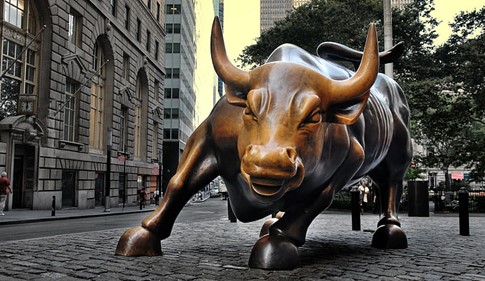Charging Bull on Wall Street
In this article, Nakul PANJABI (ESSEC Business School, Grande Ecole Program – Master in Management, 2021-2024) talks about the Charging Bull sculpture displayed on Wall Street.
About the Charging Bull sculpture
In mid of December 1989, a bronze sculpture of a bull in its charging position was dropped outside of the New York Stock Exchange. The Bull is a symbol of booming stock prices. Arturo Di Modica, an Italian-American artist, was responsible for this stunt. During the economically depressive period of late 80s, he intended to encourage optimism and hope for a prosperous future among the American Citizens. Anticlimactically, the sculpture was removed just after few hours but was placed just two blocks away from its original place.
Charging Bull sculpture on Wall Street.

Source: Arturo Di Modica.
Although the Charging Bull has already become a global symbol for an upward stock price movements and prosperity, understanding the basics of Bull and Bear markets can be useful for Investment Management. Bull market represents the time period where asset and security prices are rising, and it reflects the heightened investor confidence in the financial markets. Conversely, Bear market represents a downward movement in security prices and an increased investor pessimism. The terminology evolves from the behaviour of the animals. Bull market derives its name from the upward attacking technique of a bull and the bear market from the downward attacking technique of a bear.
Price trends
Generally, fundamental investing deals with the fundamental value of the security rather than the movement of its price. However, it does not mean that price movements are completely irrelevant in investment decisions of an individual. It is useful to know whether the market is bullish or bearish. If the security is currently overvalued according to your fundamental analysis, then the ideal action would be to sell the security while it is overvalued. But if the price is expected to rise even higher in the near future, then the rational behaviour would be to sell the Security later at that higher price and to sell it now if the price is expected to dip. Judging the market trends is an important skill to maximise returns on investment.
The price trend approach and market efficiency
Classifying a market as bull or bear derives from studying the trends in prices of assets. The method to identify patterns in price movements and forecasting the direction of price using past market data is known as technical analysis’. Profiting from technical analysis requires the market to be inefficient. It simply means that the current stock price does not reflect all the information represented in the past price points as well as all the public and private information in the market. However, it is widely assumed that developed markets are usually efficient in the semi-strong sense. This means that the prices of the assets reflect all the information from past price points and all the information publicly available. Theoretically, in such a situation an investor cannot benefit (have abnormal returns) by using technical or fundamental analysis.
However, this does not mean that studying price trends is completely useless. In markets which are inefficient, using technical analysis might be even more profitable than fundamental analysis. Generally, the developing economies such as Africa have inefficient markets. In those markets analyzing the past price points might give a reasonable edge to forecast short-term asset prices. Using fundamental analysis can also be tricky in this case. If a stock is undervalued, then the rational behavior would be to buy the stock and wait for its price to increase. However, since the market is inefficient, it is very uncertain when the prices will reflect the public information and, consequently, whether the investor will make a profit or not. In such a case, technical analysis might still work as it relies on market sentiment.
Why should I be interested in this post?
The Charging Bull sculpture on Wall Street is part of the financial culture of every business school student. It is a must see when you visit New York City.
Bull and bear markets are terms that have to be well understood by every investor in financial markets.
Related posts on the SimTrade blog
▶ Nakul PANJABI Art as a financial asset class
▶ Akshit GUPTA The animals of finance
▶ Jayati WALIA Trend Analysis and Trading Signals
▶ Jayati WALIA Moving averages
▶ Jayati WALIA Brownian Motion in Finance
Useful resources
Wikipedia Arturo Di Modica.
Antoine Bourdon (22/10/2021) Mort d’Arturo Di Modica, sculpteur du célèbre Charging Bull de Wall Street à New York Connaissances des arts.
About the author
The article was written in November 2022 by Nakul PANJABI (ESSEC Business School, Grande Ecole Program – Master in Management, 2021-2024).


Pingback: Art as an asset class - SimTrade blogSimTrade blog
Pingback: The Money Changer and his Wife - SimTrade blogSimTrade blog